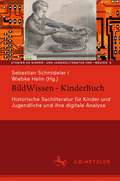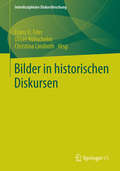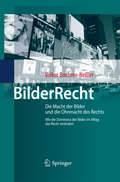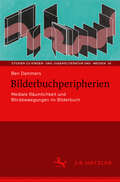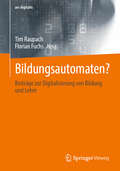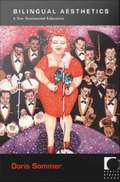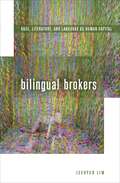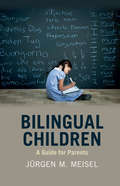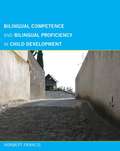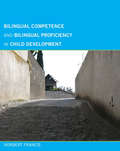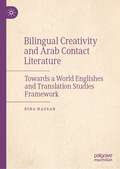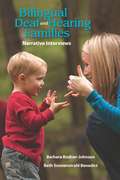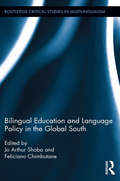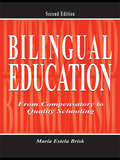- Table View
- List View
Bild - Macht - Gender: Blicke, Bilder und Geschlechterrollen in der höfischen Epik
by Ines PalauDie Untersuchung von Geschlechterbildern in der mittelalterlichen Literatur hat uns heute noch etwas zu sagen. Der Blick auf Geschlechterrollen der damaligen Zeit kann eine aktive Rolle bei der Aushandlung von Geschlechterverhältnissen in der Gegenwart spielen: Wertehierarchien, Identitätskonzepte und Handlungsnormen werden zumeist im Rückgriff auf die Vergangenheit festgelegt und legitimiert. Die Anbindung an tradierte Geschlechterformen ist ein wichtiger Baustein bei der Konstruktion von Geschlechterrollen. Mit dem Argument `So ist es doch schon immer gewesen' wird die Festlegung von Geschlechterrollen am machtvollsten fundiert. In Zeiten, in denen das Gender-Mainstreaming zum offiziellen Ziel der Europäischen Union erklärt, Geschlechtergleichstellung gleichsam ,verordnet' wird und demographische Untergangsszenarien entworfen werden, kann diese Arbeit einen Beitrag dazu leisten, ein gender-sensibles Bewusstsein zu schärfen, die heutigen Veränderungen der Geschlechterkategorien zu historisieren und den Prozess in eine konstruktive Richtung ,mitzusteuern'.
Bild, Realität und Medienkonstruktion: Eine Frame-Analyse der deutschen Mediendarstellungen von China
by Fengmin YanDieses Buch untersucht im Rahmen der Framing-Theorie, wie Nachrichtenmedien soziale Themen und Ereignisse konstruieren und dadurch bestimmte Wahrnehmungen vermitteln. Durch die Operationalisierung des medialen Framings als Interpretationsprozess durch Problemdefinition, Ursachendiagnose, moralische Wertung und Lösungsvorschläge schlägt das Buch einen systematischen und transparenten Ansatz für Bilder im Nachrichtendiskurs vor. Auf der Grundlage einer Frame-Analyse wird untersucht, wie deutsche Nachrichtenmedien eine Liste von Themen und Ereignissen mit China-Bezug rahmen und dadurch bestimmte Überzeugungen und Meinungen über dieses Land vermitteln. Darüber hinaus wird untersucht, ob es dominante Deutungsmuster gab und inwieweit unterschiedliche Sichtweisen erkennbar waren, indem zwei große Tageszeitungen mit gegensätzlicher politischer Ausrichtung - die FAZ und die taz - verglichen werden.Angeregt durch die Beziehung zwischen Bild und Wirklichkeit, untersucht das Buch die Entstehung und das Fortbestehen von Bildern anhand der medialen Konstruktion von Bedeutung und der menschlichen kognitiven Komplexität bei der Wahrnehmung anderer. Medien wählen bestimmte Themen und Ereignisse aus und interpretieren sie dann aus bestimmten Perspektiven. Eine Vielzahl professioneller und nicht-professioneller Faktoren, die hinter der Nachrichtenproduktion stehen, können zu verzerrten Darstellungen führen. Darüber hinaus können aus sozialpsychologischer Sicht ungenaue Wahrnehmungen fremder Kulturen durch kategorisches Denken, verzerrte Verarbeitung von Stimulusinformationen, Interessenkonflikte zwischen Gruppen und Bevorzugung der eigenen Gruppe entstehen.Dementsprechend geht es in diesem Buch nicht in erster Linie darum, ob die Medienberichterstattung von der Realität abweicht, sondern vielmehr um die zugrunde liegende Logik, auf der die Schlussfolgerungen und Urteile beruhen. Es trägt daher zu einem rationalen Verständnis des westlichen Diskurses bei und hat praktische Auswirkungen sowohl auf die chinesische öffentliche Diplomatie als auch auf eine konstruktivere Rolle der Nachrichtenmedien bei der Förderung des Verständnisses für andere.
Bild/Text – Text/Bild: Werkgerechte Rezeption von Bilderbüchern und illustrierten Kinderbüchern in bildlinguistischer Perspektive (Abhandlungen zur Literaturwissenschaft)
by Hans-Heino EwersTrotz der Dominanz des Audiovisuellen in unserer Zeit sind das Bilderbuch und das illustrierte (Kinder-)Buch zu einer ungeahnten künstlerischen Höhe gelangt. Die Kommunikationsmedien aus Bild und Text angemessen zu rezipieren, versteht sich nicht von selbst. Die Bildlinguistik liefert zahlreiche Anregungen dazu, wie ein Close Reading dieser bimodalen Kunstformen auszusehen hat. Entscheidend hierfür ist die jeweils vorliegende funktionale Kombination von Bild und Text, die in vier Grundformen ausdifferenziert wird. Verfolgt wird sodann, welche Rezeptionsvorgaben sich aus der typographischen Positionierung von Bild und Text ergeben. Eine besondere künstlerische Bedeutung kommt gegenwärtig dem Märchenbilderbuch und den aufwendig illustrierten Märcheneditionen zu, denen zwei Abschlusskapitel gewidmet sind. Beachtung finden daneben auch die hochkarätigen Illustrierungen von Kinderliteraturklassikern. Diese Studie geht auf eine Vielzahl intensiver Bilderbuchanalysen in universitären Lehrveranstaltungen zurück und bietet nicht zuletzt auch praktische Anregungen für eine weitere Beschäftigung mit diesen Kommunikationsmedien.
BildWelt Mission: Ästhetische Perspektiven christlicher Transkulturationsgeschichte (Horizonte Interkultureller Theologie)
by Andreas Heuser Claudia Hoffmann Stefan S. Jäger Eckhard ZemmrichDer Band akzentuiert interdisziplinäre Ansätze zu einem ästhetischen Paradigma in der Missionsgeschichtsschreibung. Veränderte Bildprogramme von Missionsgesellschaften, Erschließungsgeschichten von Bildarchiven, die Anfänge der Missionsfotografie wie des Missionsfilms oder auch ikonografische Umgestaltungen in interkulturellen Austauschbeziehungen eröffnen visuell-ästhetische Resonanzräume zur neuzeitlichen Transformationsgeschichte des Christentums. Damit regt der Eröffnungsband der Reihe „Horizonte Interkultureller Theologie&“ (HIT) Suchbewegungen eines iconic turn an.
BildWissen – KinderBuch: Historische Sachliteratur für Kinder und Jugendliche und ihre digitale Analyse (Studien zu Kinder- und Jugendliteratur und -medien #5)
by Sebastian Schmideler Wiebke HelmDie Verbreitung von Illustrationen im Kinder- und Jugendsachbuch erlebte aufgrund zunehmender Nachfrage und veränderter drucktechnischer Bedingungen im 19. Jahrhundert einen rasanten Aufschwung. Neue Reproduktionsverfahren ermöglichten die industrielle Massenfertigung und das Eindrucken von Abbildungen in den Textblock, was zu einem Anstieg an Illustrationen insgesamt und pro Buch führte. Sachgegenstände und Sachverhalte konnten so beispielsweise in der unterhaltend-belehrenden Sachliteratur für Kinder und Jugendliche besser anschaulich gemacht und veranschaulicht werden. - Der Sammelband dokumentiert die Erträge der Tagung „BildWissen – KinderBuch“. Aus inter- und transdisziplinärer Sicht werden darin (retrodigitalisierte) Kinder- und Jugendsachbücher des langen 19. Jahrhunderts untersucht. Ein Fokus liegt auf Methoden der Digital Humanities-Forschung, um das für den Einzelforscher nicht mehr zu bewältigende Bild- und Textmaterial innovativ analysieren zu können. Die Artikel loten den Beitrag dieser für die gegenwärtige Distant Viewing-Forschung aus, fragen nach Herausforderungen und Potenzialen für die historische Kinder- und Jugendbuchforschung und diskutieren Vor- und Nachteile eines korpusbasierten Ansatzes.
Bilder in historischen Diskursen (Interdisziplinäre Diskursforschung)
by Franz X. Eder Oliver Kühschelm Christina LinsbothBislang wurden in der historischen Diskursanalyse Fragen zur Funktion von Bildern in Diskursen noch wenig berücksichtigt. Die Beiträge des vorliegenden Bandes nehmen sich dieser Thematik an und zeigen, dass auch Bilder die Möglichkeitsbedingungen des Sag- und Denkbaren bestimmen. Sie widmen sich Zeichnungen, Skizzen, Drucken, Gemälden, Fotos und Diagrammen und analysieren deren mannigfältige Interaktionen mit (verbalen) Texten. Die Autoren und Autorinnen bewegen sich im weiten Rahmen der historischen Diskursanalyse, verfolgen aber auch semiologisch und praxeologisch orientierte Perspektiven. Vielfach arbeiten sie einer Mediengeschichte der Bild-Text-Kommunikation zu. Sie zeigen exemplarisch, was eine um Bilder bemühte historische Diskursanalyse leisten kann - für die Diskursanalyse selbst wie für ein Verständnis der Kommunikation mit Bildern. Gegenüber Wissenschaften, die auf Praktiken der aktuellen Bildverwendung fokussieren, kann der Blick in die Vergangenheit die Kontingenz von Regelmäßigkeiten aufzeigen und so Kurzschlüsse auf anthropologische Konstanten unterlaufen.
BilderRecht: Die Macht der Bilder und die Ohnmacht des Rechts Wie die Dominanz der Bilder im Alltag das Recht verändert
by Volker Boehme-NeßlerWir leben in einer Bilderwelt. Die Folgen sind - im wahrsten Sinn des Worts - unübersehbar. Was bedeutet die Dominanz der Bilder für das Recht? Bisher ist das Recht sehr bilderskeptisch. Das wird kaum so bleiben können, denn wenn sich ein Recht zu weit vom Leben entfernt, wird es über kurz oder lang an Bedeutung verlieren. Welche Chancen und Risiken ergeben sich, wenn Parlamente, Verwaltungen, Gerichte und Anwälte visuell kommunizieren? Der Autor diskutiert die Frage, wie ein BilderRecht aussehen könnte.
Bilderbuchperipherien: Mediale Räumlichkeit und Blickbewegungen im Bilderbuch (Studien zu Kinder- und Jugendliteratur und -medien #16)
by Ben DammersDieses Buch bietet die erste literatur- und medientheoretisch fundierte Studie zu Blickbewegungen im Bilderbuch. Es begegnet zwei Forschungsdesideraten: Der empirischen Untersuchung geht eine umfassende theoretische Auseinandersetzung mit der Räumlichkeit und Paratextualität des Bilderbuchs voraus, die bislang noch nicht vorliegt. Die Rezeptionsstudie setzt sich in zweierlei Hinsicht von bereits vorliegenden Arbeiten zur Bilderbuchrezeption ab: Anders als in Blickbewegungsstudien aus der experimentellen Psychologie wird die Komplexität des Rezeptionsgegenstandes in die Analyse der Blickbewegungen einbezogen. So setzt die Studie nicht auf bildschirmbasierte Schrift-Bild-Kombinationen oder fragmentierte Ausschnitte, sondern erforscht die Rezeptionsprozesse im Umgang mit authentischen Printbilderbüchern. So gerät auch die Relevanz von Räumlichkeit und Materialität des Mediums für die Rezeption in den Blick. Anders als bereits vorliegende Bilderbuchrezeptionsstudien aus dem literaturdidaktischen Kontext untersucht diese Studie nicht nur post hoc in einem inszenierten Setting erhobene verbale Daten (z.B. Anschlussinterviews), sondern kombiniert die Aufzeichnung von Blickdaten mit der Erhebung flankierender qualitativer Daten in einem möglichst ungesteuerten Rezeptionsprozess.
Bildungsautomaten?: Beiträge zur Digitalisierung von Bildung und Lehre (ars digitalis)
by Florian Fuchs Tim RaupachDer vorliegende Band versteht sich als interdisziplinäre Intervention in die aktuellen Debatten um die “Kultur der Digitalität” (Stalder) bzw. den Digitalisierungsprozess in Lehre und Unterricht. Die mit der Corona-Pandemie forcierte Digitalisierung von universitärer Lehre und Schulunterricht wird auf die ihr zugrundeliegende positivistisch-behavioristische Machbarkeitsideologie untersucht und somit als Teil eines neuen Herrschaftstypus sichtbar gemacht.
Bildungspotenziale von Literatur im Pflegeunterricht: Eine Untersuchung am Beispiel Sterben (BestMasters)
by Verena MüllerVerena Müller unternimmt den Versuch, eine Schnittstelle zwischen fiktionaler Literatur und der Pflegeausbildung herzustellen. Hierfür untersucht sie mit Blick in verschiedene Bezugswissenschaften, ob und wie der Einsatz von literarischen Texten den Weg zu einem ästhetischen Lernen im Pflegeunterricht bereitet. Dabei fokussiert sie exemplarisch den pflegerisch relevanten Zusammenhang von Tod und Sterben, um die Ausführungen zu rahmen. Dazu führt sie Erkenntnisse der Literaturdidaktik, der allgemeinen Erziehungswissenschaften und der Medical Humanities hinsichtlich des Einsatzes von literarischen Texten zusammen, setzt diese in Bezug zu den Zielen der Pflegedidaktik und leitet relevante Aspekte ab. Anknüpfend an die Ergebnisse zeigt sie in einer pflegedidaktischen Analyse zweier literarischer Texte beispielhaft pflegedidaktische Gewinne auf.
Bildungsroman and the Arab Novel: Egyptian Intersections (Routledge Advances in Middle East and Islamic Studies)
by Maria Elena PaniconiThrough a close-reading of a corpus of novels featuring young protagonists in their path toward adulthood, the book shows how Bildungsroman impacted the formation of the Egyptian narrative. On a larger scale, the book helps the reader to understand the key role played by the coming of age novel in the definition and perception of modern Arab subjectivity. Exploring the role of Bildungsroman in shaping the canonical Egyptian novel, the book discusses the case of Zaynab by Muhammad Husayn Haykal (1913) as an example of early Arab Bildungsnarrative. It focuses on Latifa Zayyat’s masterpiece The Open Door and the novels of the 90es Generation, offering a gender-based analysis of the Egyptian Bildungsroman. It provides insightful readings about the function of the novel in women’s re-negotiation of social boundaries. The study shows how the stories of youth present universal themes such as the thwarted quest for love, the struggle for personal fulfilment, the desire to achieve a cultural modernity often felt as "other than self". The book is a journey in the Twentieth Century Egyptian Novel, seen through the lens of the transnational form of Bildungsroman. It is a key resource to students and academics interested in Arabic literature, comparative literature and cultural studies.
Bilingual Aesthetics: A New Sentimental Education
by Doris SommerKnowing a second language entails some unease; it requires a willingness to make mistakes and work through misunderstandings. The renowned literary scholar Doris Sommer argues that feeling funny is good for you, and for society. In Bilingual Aesthetics Sommer invites readers to make mischief with meaning, to play games with language, and to allow errors to stimulate new ways of thinking. Today's global world has outgrown any one-to-one correlation between a people and a language; liberal democracies can either encourage difference or stifle it through exclusionary policies. Bilingual Aesthetics is Sommer's passionate call for citizens and officials to cultivate difference and to realize that the precarious points of contact resulting from mismatches between languages, codes, and cultures are the lifeblood of democracy, as well as the stimulus for aesthetics and philosophy. Sommer encourages readers to entertain the creative possibilities inherent in multilingualism. With her characteristic wit and love of language, she focuses on humor--particularly bilingual jokes--as the place where tensions between and within cultures are played out. She draws on thinking about humor and language by a range of philosophers and others, including Sigmund Freud, Immanuel Kant, Ludwig Wittgenstein, Hannah Arendt, and Mikhail Bakhtin. In declaring the merits of allowing for crossed signals, Sommer sends a clear message: Making room for more than one language is about value added, not about remediation. It is an expression of love for a contingent and changing world.
Bilingual Brokers: Race, Literature, and Language as Human Capital
by Jeehyun LimReading Asian American and Latino literature, Bilingual Brokers traces the shift in attitudes toward bilingualism in postwar America from the focus on cultural assimilation to that of resource management. Interweaving the social significance of language as human capital and the literary significance of English as the language of cultural capital, Jeehyun Lim examines the dual meaning of bilingualism as liability and asset in relation to anxieties surrounding “new” immigration and globalization.Using the work of Younghill Kang, Carlos Bulosan, Américo Paredes, Maxine Hong Kingston, Richard Rodriguez, Chang-rae Lee, Julia Alvarez, and Ha Jin as examples, Lim reveals how bilingual personhood illustrates a regime of flexible inclusion where an economic calculus of one’s value crystallizes at the intersections of language and racial difference. By pointing to the nexus of race, capital, and language as the focal point of postwar negotiations of difference and inclusion, Bilingual Brokers probes the faultlines of postwar liberalism in conceptualizing and articulating who is and is not considered to be an American.
Bilingual Children: A Parents' Guide
by Jürgen MeiselAre you raising your child bilingually, or planning to do so in the future, but are unsure how to proceed? Using a question-and-answer format, this practical and reassuring guide will enable readers to make informed decisions about how to raise their child with two or more languages. To grow up bilingually is a necessity or an opportunity for more children today than ever before. However, parents are frequently uncertain about what to do, or even fear that they may be putting their child's development at risk. Disentangling fact from myth, it shows that a child can acquire more than one 'first' language simultaneously and that one language need not have negative effects on the other. Each chapter is devoted to a question typically asked by parents in counselling sessions, followed by a concise answer, summaries of the evidence and practical tips.
Bilingual Community Education and Multilingualism
by Zeena Zakharia Ofelia GarcíaThis book explores bilingual community education, specifically the educational spaces shaped and organized by American ethnolinguistic communities for their children in the multilingual city of New York. Employing a rich variety of case studies which highlight the importance of the ethnolinguistic community in bilingual education, this collection examines the various structures that these communities use to educate their children as bilingual Americans. In doing so, it highlights the efforts and activism of these communities and what bilingual community education really means in today's globalized world. The volume offers new understandings of heritage language education, bilingual education, and speech communities for bilingual Americans in the 21st century.
Bilingual Competence and Bilingual Proficiency in Child Development
by Norbert FrancisWhen two or more languages are part of a child's world, we are presented with a rich opportunity to learn something about language in general and about how the mind works. In this book, Norbert Francis examines the development of bilingual proficiency and the different kinds of competence that come together in making up its component parts. In particular, he explores problems of language ability when children use two languages for tasks related to schooling, especially in learning how to read and write. He considers both broader research issues and findings from an ongoing investigation of child bilingualism in an indigenous language--speaking community in Mexico. This special sociolinguistic context allows for a unique perspective on some of the central themes of bilingualism research today, including the distinction between competence and proficiency, modularity, and the Poverty of Stimulus problem. Francis proposes that competence (knowledge) should be considered as an integral component of proficiency (ability) rather than something separate and apart, arguing that this approach allows for a more inclusive assessment of research findings from diverse fields of study. The bilingual indigenous language project illustrates how the concepts of modularity and the competence-proficiency distinction in particular might be applied to problems of language learning and literacy. Few investigations of indigenous language and culture approach bilingual research problems from a cognitive science perspective. By suggesting connections to broader cognitive and linguistic issues, Francis points the way to further research along these lines.
Bilingual Competence and Bilingual Proficiency in Child Development
by Norbert FrancisA study of first and second language development in an indigenous community with implications for broader linguistic and cognitive issues.When two or more languages are part of a child's world, we are presented with a rich opportunity to learn something about language in general and about how the mind works. In this book, Norbert Francis examines the development of bilingual proficiency and the different kinds of competence that come together in making up its component parts. In particular, he explores problems of language ability when children use two languages for tasks related to schooling, especially in learning how to read and write. He considers both broader research issues and findings from an ongoing investigation of child bilingualism in an indigenous language–speaking community in Mexico. This special sociolinguistic context allows for a unique perspective on some of the central themes of bilingualism research today, including the distinction between competence and proficiency, modularity, and the Poverty of Stimulus problem.Francis proposes that competence (knowledge) should be considered as an integral component of proficiency (ability) rather than something separate and apart, arguing that this approach allows for a more inclusive assessment of research findings from diverse fields of study. The bilingual indigenous language project illustrates how the concepts of modularity and the competence-proficiency distinction in particular might be applied to problems of language learning and literacy.Few investigations of indigenous language and culture approach bilingual research problems from a cognitive science perspective. By suggesting connections to broader cognitive and linguistic issues, Francis points the way to further research along these lines.
Bilingual Creativity and Arab Contact Literature: Towards a World Englishes and Translation Studies Framework
by Dina HassanThis book adopts an integrated approach to the study of contact literature through collaboration between theories of World Englishes and translation studies. The author proposes an interactive framework that integrates linguistic and cultural perspectives, through the analysis of selected Anglo-Arab and Arab-American contact literary texts: Samia Serageldine’s The Cairo House (2000), Leila Ahmed’s A Border Passage (1999), Leila Aboulela’s The Translator (1999), Ahdaf Soueif’s The Map of Love (2000), and Abdelkebir Khatibi’s Love in Two Languages (1990). The author then discusses the pedagogical implications of bilingual creativity via a language in literature approach. This book will be of interest to students and scholars of translation studies, literature and cultural studies.
Bilingual Deaf and Hearing Families: Narrative Interviews
by Barbara Bodner-Johnson Beth Sonnenstrahl BenedictThis study emphasizes the importance of family support for deaf members, particularly through the use of both American Sign Language (ASL) and spoken and/or written English. Research has shown how these factors influence such areas as a child's development, performance in school, and relationships with brothers and sisters. In this volume, authors Barbara Bodner-Johnson and Beth S. Benedict concentrate on the vital, positive effects of bilingualism and how families that share their experiences with other families can enhance all of their children's achievement and enrichment. Bilingual Deaf and Hearing Families: Narrative Interviews describes the experiences of ten families who have at least one deaf family member. In five of the families, the parents are hearing and they have a deaf child; two of the children in these families have cochlear implants. In three families, both the parents and children are deaf. In one family, the parents are deaf and their daughter is hearing; and in one family, the parents and one child are deaf and they all have cochlear implants, and the deaf child's twin is hearing. The interviews were conducted in the families' homes using set topics and questions. The family discussions cover a wide range of subjects: cochlear implants, where they live, their thoughts about family relationships, how they participate in the Deaf community, how they arrive at certain decisions, their children's friendships, and the goals and resiliencies they have as a family.
Bilingual Education and Language Policy in the Global South (Routledge Critical Studies in Multilingualism #4)
by Jo Arthur Shoba Feliciano ChimbutaneThis volume considers a range of ways in which bilingual programs can make a contribution to aspects of human and economic development in the global South. The authors examine the consequences of different policies, programs, and pedagogies for learners and local communities through recent ethnographic research on these topics. The revitalization of minority languages and local cultural practices, management of linguistic and cultural diversity, and promotion of equal opportunities (both social and economic) are all explored in this light.
Bilingual Education and Minority Language Maintenance in China: The Role of Schools in Saving the Yi Language (Multilingual Education #31)
by Linda Tsung Lubei ZhangThis book looks closely at Yi bilingual education practice in the southwest of China from an educationalist’s perspective and, in doing so, provides an insight toward our understanding of minority language maintenance and bilingual education implementation in China. The book provides an overview on the Yi people since 1949, their history, society, culture, customs and languages. Adopting the theory of language ecology, data was collected among different Yi groups and case studies were focused on Yi bilingual schools. By looking into the application of the Chinese government’s multilingual language and education policy over the last 30 years with its underlying language ideology and practices the book reveals the de facto language policy by analyzing the language management at school level, the linguistic landscape around the Yi community, as well as the language attitude and cultural identities held by present Yi students, teachers and parents. The book is relevant for anyone looking to more deeply understand bilingual education and language maintenance in today’s global context.
Bilingual Education in the 21st Century
by Ofelia GarcíaBilingual Education in the 21st Century examines languages and bilingualism as individual and societal phenomena, presents program types, variables, and policies in bilingual education, and concludes by looking at practices, especially pedagogies and assessments. This thought-provoking work is an ideal textbook for future teachers as well as providing a fresh view of the subject for school administrators and policy makers.Provides an overview of bilingual education theories and practices throughout the worldExtends traditional conceptions of bilingualism and bilingual education to include global and local concerns in the 21st centuryQuestions assumptions regarding language, bilingualism and bilingual education, and proposes a new theoretical framework and alternative views of teaching and assessment practicesReviews international bilingual education policies, with separate chapters dedicated to US and EU language policy in educationGives reasons why bilingual education is good for all children throughout the world, and presents cases of how this is being carried out
Bilingual Education: From Compensatory to Quality Schooling (2nd Edition)
by María Estela BriskBilingual Education: From Compensatory to Quality Schooling, Second Edition maintains its original purpose of synthesizing the research on successful bilingual education in order to demonstrate that quality bilingual education is possible and desirable.Findings from a wide range of studies are integrated to provide a clear picture of bilingual education in today's schools, and a professional understanding of the foundations and issues surrounding bilingual education programs. The recommendations offered provide a comprehensive basis for planning, developing, improving, and evaluating bilingual programs. For clarity, these recommendations are discussed with respect to the whole school, the curriculum, and the classroom, but it is stressed that they need to be applied in a holistic way because they depend on each other. All educators who work or will work with bilingual students--classroom teachers, administrators, and curricula developers--will find the information in this text essential and will appreciate the straightforward approach and easy reading style.New in the Second Edition:*A new Chapter 1, Pursuing Successful Schooling, includes the definition of success that frames the content of the book, and a review of how the research on bilingual education has changed.*Chapter 2, Bilingual Education Debate, is substantially revised to address major changes in demographics and legislation.*Chapter 3, Contextual and Individual Factors: Supports and Challenges, is updated to include important new research on the external and internal factors affecting learners and a new section on peers.*Chapter 4, Creating a Good School, is reorganized and updated.*Chapter 5, Creating Quality Curriculum, is updated throughout, particularly the sections on teaching content areas and assessment.*Chapter 6, Creating Quality Instruction, includes extensive new material in the sections on "Teaching English and In English" and "Teaching Students with Limited Schooling."*Chapter 7, Beyond the Debate, has an extensive new section describing and analyzing how the framework for quality education can be used as a guide to help create a new program.
Bilingual Education: Teachers' Narratives
by Nancy LembergerThis book grew out of the joys and challenges the author experienced as a Spanish/English bilingual teacher of culturally and linguistically diverse students. It tells what it is like to be a bilingual teacher. As a result, it helps other teachers and prospective teachers understand the complex nature of bilingual teaching, shares some successful teaching strategies that other teachers have used, and encourages teachers to find their own solutions despite limited support. The book is structured in three parts. The introduction explains how the book evolved, defines its relation to other qualitative research, and offers suggestions for how to use the book. The second part consists of eight bilingual teachers' stories that provide a glimpse of them as people, their schools and programs, their successes and struggles, and their solutions and coping mechanisms within their contexts. It concludes with a discussion chapter that looks at the teachers' collective strengths and struggles comparatively, connecting these to broader issues. The final section presents bilingual education resources -- useful information for practitioners. This includes foundation texts on the theories and practices of bilingual education, demographic information, a glossary of bilingual education terms, listings of curricula, tests, and literature mentioned by the teachers, and professional network sources.
Bilingual Figurative Language Processing
by Roberto R. Heredia Anna B. CieślickaBilingual Figurative Language Processing is a timely book that provides a much-needed bilingual perspective to the broad field of figurative language. This is the first book of its kind to address how bilinguals acquire, store, and process figurative language, such as idiomatic expressions (e. g. , kick the bucket), metaphors (e. g. , lawyers are sharks), and irony, and how these tropes might interact in real time across the bilingual's two languages. This volume offers the reader and the bilingual student an overview of the major strands of research, both theoretical and empirical, currently being undertaken in this field of inquiry. At the same time, Bilingual Figurative Language Processing provides readers and undergraduate and graduate students with the opportunity to acquire hands-on experience in the development of psycholinguistic experiments in bilingual figurative language. Each chapter includes a section on suggested student research projects. Selected chapters provide detailed procedures on how to design and develop psycholinguistic experiments.




